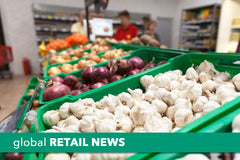
June Retail Sales Show Unexpected Resilience Amid Economic Challenges
Table of Contents
- Key Highlights:
- Introduction
- Overview of June's Retail Performance
- Food Sales: The Driving Force
- Non-Food Sales: A Gradual Recovery
- The Online Shopping Landscape
- Consumer Spending Patterns: A Broader Perspective
- The Role of Seasonal Trends
- Retailers' Strategies for Growth
- Challenges Ahead
- Conclusion
- FAQ
Key Highlights:
- Retail sales in the UK increased by 3.1% year-on-year in June, marking a rebound from a 0.2% decline in June 2024.
- Food sales surged by 4.1%, primarily driven by ongoing food inflation, while non-food sales grew by 2.2%.
- Despite a rising trend in online shopping, in-store non-food sales also saw an increase, defying earlier reports of weak foot traffic due to heat.
Introduction
The retail landscape in the UK has faced significant challenges recently, with fluctuating sales figures and changing consumer behaviors. However, the latest data from the British Retail Consortium (BRC) and KPMG Retail Sales Monitor has unveiled a more optimistic narrative for June 2024. The report reveals a notable increase in retail sales, contrasting sharply with previous months' declines. This article delves into the factors contributing to this rebound, examining the performance across various categories and what it means for the future of retail in the UK.
Overview of June's Retail Performance
The BRC-KPMG Retail Sales Monitor has provided evidence of a robust recovery in retail sales during June, with total sales rising by 3.1% compared to the same period last year. This marks a significant turnaround from the decline seen in June 2024, where sales had dipped by 0.2%. The increase can be attributed primarily to strong food sales, which grew by 4.1% amidst ongoing inflationary pressures.
Interestingly, while food sales took center stage, non-food sales also demonstrated resilience, showing a 2.2% increase in June. This is a noteworthy improvement compared to the 1.9% decline recorded in the same month last year. Categories such as clothing, footwear, and health and beauty products all contributed to this positive trend, suggesting a broader recovery across different segments of the retail market.
Food Sales: The Driving Force
Food sales have emerged as a critical driver behind the overall growth in retail sales, with a significant 4.1% increase reported in June. This rise is largely attributed to food inflation, which has been on an upward trajectory throughout the year. Consumers continue to feel the pinch of rising prices, yet this has not deterred them from purchasing essential food items.
Helen Dickinson, CEO of the British Retail Consortium, highlighted that the soaring temperatures during June also played a role in boosting food sales. The demand for electric fans, for instance, surged as consumers sought relief from the heat. Additionally, the onset of summer and events like Wimbledon further stimulated sales in sports and leisure equipment, indicating that seasonal trends significantly influence consumer purchasing behavior.
Non-Food Sales: A Gradual Recovery
While food sales lead the recovery, the non-food sector also demonstrated encouraging growth. The increase of 2.2% in non-food sales in June is particularly notable, especially given the previous year's decline of 1.9%. This improvement suggests a growing consumer confidence, with shoppers willing to spend on discretionary items.
Categories such as clothing, footwear, jewellery, and health and beauty all saw positive sales trends. Clothing sales, however, saw a more modest rise. The warm weather and the start of the holiday season likely contributed to this uptick, as consumers prepared for summer vacations and events.
Interestingly, despite reports of weak foot traffic in stores due to high temperatures, in-store non-food sales managed to increase. This resilience suggests that while online shopping continues to be a preferred channel for many, physical retail still holds significant appeal, particularly during promotional periods.
The Online Shopping Landscape
The online shopping trend remains a crucial component of the retail landscape. The penetration rate for online non-food sales remained steady at 36.6%, mirroring figures from a year ago. This slight dip from the 12-month average of 36.8% indicates a stabilization in online shopping habits, suggesting that consumers are finding a balance between online and in-store experiences.
Retailers have increasingly invested in their online platforms, enhancing user experiences, and expanding their product ranges. However, the consistent performance of in-store sales points to a possible resurgence in physical shopping, driven by consumers' desire for immediate gratification and the tactile experience of browsing products.
Consumer Spending Patterns: A Broader Perspective
Separate data from Barclays presents a more nuanced picture of consumer spending. While retail sales have rebounded, overall consumer card spending, which includes hospitality and leisure, fell by 0.1% year-on-year. Essential spending, which encompasses food and fuel, decreased by 2.1%. These figures indicate that while consumers are willing to spend on retail goods, there are still concerns regarding overall economic conditions that are affecting discretionary expenditures.
Interestingly, the report shows that consumers remain enthusiastic about experiences. Non-essential spending edged up by 0.8%, fueled by a resurgence in summer festivals, weddings, and sports events. Spending in hospitality and leisure grew by 2.1%, highlighting a shift in consumer preferences towards experiences over material goods.
The Role of Seasonal Trends
Seasonal trends heavily influence consumer behavior, particularly during the summer months. Retailers often capitalize on this by offering promotions and discounts, which can entice consumers to make purchases. The start of the holiday season, combined with warm weather, typically leads to increased sales in categories like clothing and outdoor equipment.
Retailers have also adapted to changing consumer preferences by enhancing their offerings around seasonal events. For instance, the start of Wimbledon boosted sales of sports equipment, while summer promotions on home appliances and homeware attracted new buyers looking to refresh their living spaces.
Retailers' Strategies for Growth
To capitalize on the recovery in retail sales, retailers are implementing various strategies aimed at enhancing customer experience and driving sales. Promotions, loyalty programs, and personalized marketing efforts are becoming more prevalent as businesses seek to attract and retain customers.
Investing in online capabilities is also a critical focus for many retailers. As online shopping remains a key channel, providing seamless, user-friendly experiences is essential. This includes optimizing websites for mobile use, enhancing delivery options, and improving customer service through chatbots and live support.
Additionally, retailers are increasingly aware of the need to leverage data analytics to understand consumer behavior better. By analyzing shopping trends and preferences, businesses can tailor their offerings to meet the evolving needs of their customers.
Challenges Ahead
Despite the positive outlook for June, challenges remain on the horizon for UK retailers. Inflation continues to be a pressing concern, affecting both operational costs and consumer purchasing power. As prices rise, consumers may become more cautious with their spending, particularly in non-essential categories.
Furthermore, the ongoing economic uncertainty, influenced by factors such as geopolitical tensions and potential changes in government policy, poses risks to consumer confidence. Retailers must navigate these challenges while striving to maintain growth and profitability.
Conclusion
The data from June 2024 paints a hopeful picture for the UK retail sector, with a notable increase in sales across both food and non-food categories. The resilience of in-store sales, coupled with the steady online shopping trend, suggests that consumers are adapting to the current economic climate.
As retailers strategize for the future, understanding consumer behavior, leveraging technology, and responding to economic challenges will be pivotal in sustaining growth. The coming months will be crucial as retailers aim to build on this momentum and further enhance their offerings to meet the demands of an ever-evolving market landscape.
FAQ
What contributed to the increase in retail sales in June? The increase in retail sales can be attributed to a combination of factors, including strong food sales driven by inflation, seasonal trends, and effective promotional strategies by retailers.
How did non-food sales perform compared to previous years? Non-food sales rose by 2.2% in June, recovering from a decline of 1.9% in the same period last year, indicating a growing consumer confidence in discretionary spending.
What impact has inflation had on consumer spending? Inflation has led to increases in food prices, which has affected overall consumer spending patterns. While essential spending has decreased, non-essential spending on experiences has seen a slight uptick.
How are retailers adapting to changing consumer preferences? Retailers are enhancing their online platforms, implementing promotions, and utilizing data analytics to better understand consumer behavior and tailor their offerings accordingly.
What challenges do retailers face moving forward? Retailers are grappling with ongoing inflation, economic uncertainty, and potential changes in government policy, which may impact consumer confidence and spending habits.
Power your ecommerce with our weekly insights and updates!
Blijf op de hoogte van wat er gebeurt in de wereld van de handel
E-mailadres
Handpicked for You

15 July 2025 / Blog
From Code to Commerce: The Inspiring Journey of Shopify's Tobias Lütke
Lees Meer
15 July 2025 / Blog
Revolutionizing Retail: The Impact of AI-Powered Personalization on E-Commerce
Lees Meer
15 July 2025 / Blog


